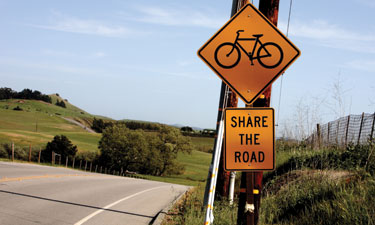 Ed. Note: An important legislative priority highlighted at March’s Legislative Forum was the need to reauthorize critical transportation programs that provide federal funding for local walking and biking projects. The current law (known as MAP-21), covering everything from highways, bridges and public transit to trails, bike paths and pedestrian safety improvements, expires in October. Additionally, the primary source of funding for MAP-21 — the Highway Trust Fund — is scheduled to be exhausted by August.
Ed. Note: An important legislative priority highlighted at March’s Legislative Forum was the need to reauthorize critical transportation programs that provide federal funding for local walking and biking projects. The current law (known as MAP-21), covering everything from highways, bridges and public transit to trails, bike paths and pedestrian safety improvements, expires in October. Additionally, the primary source of funding for MAP-21 — the Highway Trust Fund — is scheduled to be exhausted by August.
Congress has started to hold hearings on the transportation law and to consider how to fund the next bill. This gives us just a few months to work with Congress to help them understand the impact of MAP-21 on creating safe and accessible means of local travel for pedestrians and bicyclists, as well as promoting healthy and more livable communities through smart and safe transportation design.
We asked U.S. Representative Earl Blumenauer of Oregon, founder of the Congressional Bike Caucus, for his take on the challenging road ahead and the outlook for action by this fall.
Throughout my more than 40 years in public service, I have pushed for smarter and more efficient investments in transportation — investments that support the growth of vibrant cities and reject modeling downtowns like suburban malls.
Communities across the country are realizing that bright, motivated young people, who can live and work almost anywhere in the world, want more choices for transportation, which increasingly do not involve being trapped behind the wheel of a car for 10 to 20 hours a week. These communities are choosing to invest in streetcars, bicycle and pedestrian infrastructure, downtown housing and zero-emission buildings, empowering a different lifestyle for young people, empty nesters and everyone in between.
One of the most important trends in America is that people are driving less, especially younger drivers. Recent analysis shows nine years of declining driving across the board, a 40 percent increase in young people’s transit utilization and a 25 percent increase in cycling. The federal government needs to recognize these trends and partner with communities that are leading the way.
Currently, federal investment in public transportation and other alternative methods is woefully inadequate. In 2011, the Federal Highway Administration estimated that more than $71 billion worth of repairs were needed merely to maintain safe bridges, and the American Society of Civil Engineers estimates that we need to invest $2 trillion in surface transportation by 2020. Delaying this investment isn’t free. Congestion alone cost the American economy more than $100 billion last year, and it costs every American family $1,060 a year.
The federal bill that provides the majority of funding for our roads, highways and bridges, known as MAP-21, expires October 1. MAP-21 also supports the programs that make our communities more livable — programs like Safe Routes to School, Recreational Trails and Transportation Enhancements. States are already cutting back projects, and, without meaningful Congressional action by October 1, will receive almost no new federal money for transportation.
In the version of MAP-21 that became law in 2012, funding for alternative transportation choices was cut by almost a third. Instead of supporting the broad-based coalition that the National Recreation and Park Association is a part of, Congress executed a U turn, stripping out programs that were the most popular and needed at the local level. We must not allow this to happen again.
So far, there has been little serious effort in Congress to address the critical lack of funding, and time is running out. The leaders of the Senate Environment and Public Works Committee and the House Transportation and Infrastructure Committee have pledged to have a six-year transportation bill on the floor this summer, but they have reached no consensus on how to pay for it. The Congressional Budget Office estimates that a six-year bill would require $100 billion in additional revenue to make up for a dying gas tax, just to continue current funding.
While the question we are facing now in Congress is specifically about renewing our transportation funding, it is also symbolic of the path that we want to head down as a nation. If states can’t even find the money to repair major roads, how likely are they to pay for new parks, bike paths and sidewalks? From hundreds of conversations I have had with thousands of people as a member of the Oregon state legislature, Portland city commissioner and founder of the Congressional Bike Caucus, I know that these are issues that individuals care deeply about and think about on a day-to-day basis.
Making these investments in our transportation system now will save us money in the long run — there’s no doubt about that. But the choices we make before October will also determine the types of lives that our families have over the next months and years as we shape the communities around us and allow more Americans to live in places that are healthier, safer, more active and more economically secure.
I’ve been joined by a large coalition of groups, including AAA, the U.S. Chamber of Commerce, the League of American Bicyclists, 17 governors and 31 state chambers of commerce, in urging Congress to find a stable, long-term source of funding for a six-year transportation bill. Only then can we move forward with a federal policy that is right for the times, that extracts full value for the taxpayer and enhances livability.
Learn more information on NRPA’s Federal Transportation Legislative Platform.
Rep. Earl Blumenauer represents Oregon’s 3rd District in the U.S. House of Representatives.

